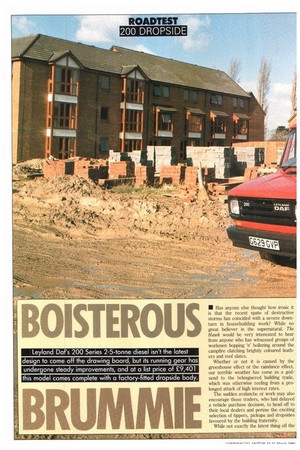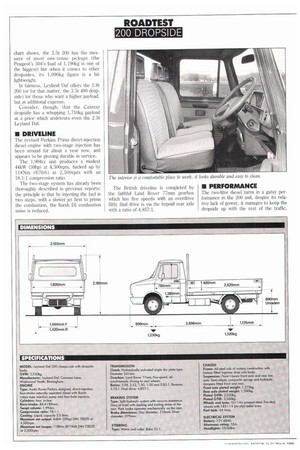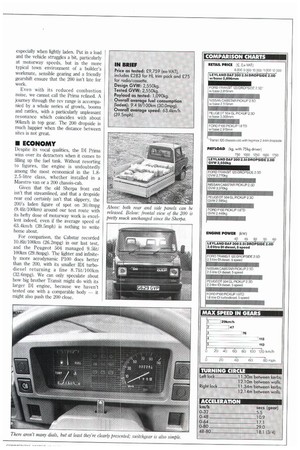30ISTER
Page 38

Page 39

Page 40

Page 41

If you've noticed an error in this article please click here to report it so we can fix it.
BRUIVINUE
• Has anyone else thought how ironic it is that the recent spate of destructive storms has coincided with a severe downturn in housebuilding work? While no great believer in the supernatural, The Hawk would be very interested to hear from anyone who has witnessed groups of workmen hopping 'n' hollering around the campfire clutching brightly coloured feathers and roof slates.
Whether or not it is caused by the greenhouse effect or the raindance effect, our terrible weather has come as a godsend to the beleaguered building trade, which was otherwise reeling from a prolonged attack of high interest rates.
The sudden avalanche or work may also encourage those traders, who had delayed a vehicle purchase decision, to head off to their local dealers and peruse the exciting selection of tippers, pickups and dropsides favoured by the building fraternity.
While not exactly the latest thing off the drawing boards (should that be computer screens?), our test vehicle this week — the Leyland Daf 200 2.5t diesel dropside — could well be worth a look.
The old Sherpa body hasn't changed much over the years, but the running gear has certainly undergone a process of gradual improvement, and for a list price of .£9,401 this model not only comes complete with a factory-fitted dropside body, but also sports novelties like a two-stage direct injection diesel engine and composite springs.
• BODYWORK
Leyland Daf is fortunate in having the ability to fit selected bodywork to its chassis at its Common Lane, Birmingham factory. The 200 Series is offered with an Ingimex aluminium dropside body which is supplied by its manufacturers to Leyland Daf in kit form.
This arrangement has the advantage of producing a vehicle which is covered by a single warranty, and also one which is available ex-stock from your local dealer.
The body in question is typical of Ingimex's dropsides, and has attractive extruded aluminium side panels, a ladder gantry and a resin-coated timber floor. Both sides and tail panel can be released using over-centre catches. They can then be held by chains or left to swing free. If required the panels can be detached completely to create a flatbed.
With its aluminium and wood construction, the body will avoid the corrosion problems which afflict a used-and-abused steel body, and it looks to be reasonably durable. The size and pricing of the 200 brings it into competition not only with dropsides based on chassis from the Transit class (including the notably successful Nissan Cabstar), but also with the top end of the one-tonne pickup market; so it is worth looking at the pros and cons of each as a working vehicle.
As far as size is concerned, the dropside contingent wins conclusively over the pickups; Leyland Des body has an interior length of 2.62m and a width of 1.80m, compared with the Ford P100 pickup's 2.0m and 1.37m.
Bring convenience into the equation and the dropside.s score again, for floors without wheelarch intrusions, and for access from the sides as well as the rear. On the debit side, the loading height of the dropsides is that much higher — comparing the 200 with the P100 again, the unladen heights are 8 9 Omm and 7 1 2mm respectively.
For those matching the Leyland Daf against the Nissan Cabstar, honours are more or less even: the 200 has a shorter but wider load bed, with roughly the same loading height.
When it comes to payload, matters become a little different. As our comparison chart shows, the 2.5t 200 has the measure of most one-tonne pickups (the Peugeot's 504's load of 1,190kg is one of the biggest) but when it comes to other dropsides, its 1,090kg figure is a bit lightweight.
In fairness, Leyland Daf offers the 2.8t 200 (or for that matter, the 3.51 400 dropside) for those who want a higher payload, but at additional expense.
Consider, though, that the Cabstar dropside has a whopping 1,710kg payload at a price which undercuts even the 2.5t Leyland Dal
• DRIVELINE
The revised Perkins Prima direct-injection diesel engine with two-stage injection has been around for about a year now, and appears to be proving durable in service.
The 1,994cc unit produces a modest 44kW (59hp) at 4,500rpm, backed up by 118Is (87Ibft) at 2,500rpm with an 18.1:1 compression ratio.
The two-stage system has already been thoroughly described in previous reports: the principle is that by injecting the fuel in two steps, with a slower jet first to prime the combustion, the harsh DI combustion noise is reduced.
The British driveline is completed by the faithful Land Rover 77mm gearbox which has five speeds with an overdrive fifth; final drive is via the hypoid rear axle with a ratio of 4.857:1.
• PERFORMANCE
The two-litre diesel turns in a gutsy performance in the 200 and, despite its relative lack of power, it manages to keep the dropside up with the rest of the traffic, especially when lightly laden. Put in a load and the vehicle struggles a bit, particularly at motorway speeds, but in the more typical town environment of a builder's workmate, sensible gearing and a friendly gearshift ensure that the 200 isn't late for work.
Even with its reduced combustion noise, we cannot call the Prima refined. A journey through the rev range is accompanied by a whole series of growls, booms and rattles, with a particularly unpleasant resonance which coincides with about 90krn/h in top gear. The 200 dropside is much happier when the distance between sites is not great.
II ECONOMY
Despite its vocal qualities, the DI Prima wins over its detractors when it comes to filling up the fuel tank. Without resorting to figures, the engine is undoubtedly among the most economical in the 1.82.5-litre class, whether installed in a Maestro van or a 200 chassis-cab.
Given that the old Sherpa front end isn't that streamlined, and that a dropside rear end certainly isn't that slippery, the 200's laden figure of spot on 30.0mpg (9.41it/1001cm) around our test route with its hefty dose of motorway work is excellent indeed, even if the average speed of 63.4km/h (39.5mph) is nothing to write home about.
For comparison, the Cabstar recorded 10.81it/100km (26.2mpg) in our last test, and the Peugeot 504 managed 9.51it/ 100km (29.8mpg). The lighter and infinitely more aerodynamic P100 does better than the 200, with its smaller ID1 turbodiesel returning a fine 8.71it/100km (32.6mpg). We can only speculate about how big brother Transit might do with its larger DI engine, because we haven't tested one with a comparable body — it might also push the 200 close.




















































































































































